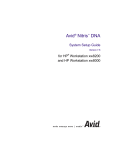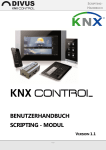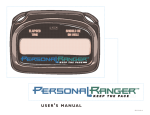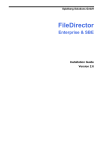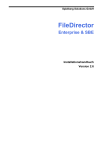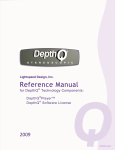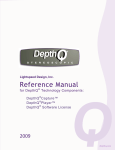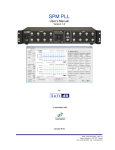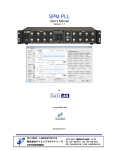Download Avid Technology DS 4.02 Product specifications
Transcript
4.02 INSTALLATION & ADMINISTRATION GUIDE The Avid|DS 4.02 Installation & Administration Guide was written by Patrick Bayne, Geneviève Laberge, Sylvain Labrosse, and Dominic Mercier and edited by Liven Tam. Formatting, layout, and illustrations by Luc Langevin and Jim Royal. © 1999–2001 Avid Technology, Inc. All rights reserved. Avid, the Avid|DS Logo, and Softimage are registered trademarks, and Equinox and MediaDock are trademarks of Avid Technology, Inc. QuickTime and the QuickTime logo are trademarks used under license from Apple Computer, Inc. InstallShield is a registered trademark of InstallShield Software Corporation. All other trademarks contained herein are the properties of their respective owners. The Avid|DS application uses JScript and Visual Basic Scripting Edition from Microsoft Corporation. The Avid|DS application contains portions of imaging code owned and copyrighted by Pegasus Imaging Corporation, Tampa, FL. This document is protected under copyright law. The contents of this document may not be copied, duplicated or distributed in any form, in whole or in part, without the express written permission of Avid Technology, Inc. This document is supplied as a guide for the Avid|DS product. Reasonable care has been taken in preparing the information it contains. However, this document may contain omissions, technical inaccuracies, or typographical errors. Product specifications are subject to change without notice and should not be considered commitments by Avid Technology, Inc. Avid Technology, Inc. does not accept responsibility of any kind for customers’ losses due to the use of this document. This document may contain confidential and proprietary information of Avid Technology, Inc. and Softimage Co. and/or other third parties which is protected by copyright, trade secret and trademark Law and may not be provided or otherwise made available without prior written authorization. Warranties and Liabilities NEITHER SOFTIMAGE CO. NOR AVID TECHNOLOGY, INC. MAKE ANY WARRANTIES, EXPRESS OR IMPLIED, INCLUDING WITHOUT LIMITATION, ANY WARRANTIES OF MERCHANTABILITY OR FITNESS FOR A PARTICULAR PURPOSE, IN THIS DOCUMENT WITH RESPECT TO THIRD PARTY PRODUCT(S) CERTIFIED OR OTHERWISE MADE AVAILABLE FOR USE WITH SOFTIMAGE PRODUCTS. ALL WARRANTIES ARE PROVIDED BY THE ORIGINAL SUPPLIER(S) OF SUCH THIRD PARTY PRODUCT(S). FCC Notice This device complies with Part 15 of the FCC Rules. Operation is subject to the following two conditions: 1. This device may not cause harmful interference. 2. This device must accept any interference received, including interference that may cause undesired operation. This equipment has been tested and found to comply with the limits for a Class A digital device, pursuant to Part 15 of the FCC Rules. These limits are designed to provide reasonable protection against harmful interference when the equipment is operated in a commercial environment. This equipment generates, uses, and can radiate radio frequency energy and, if not installed in accordance with the instruction manual, may cause harmful interference to radio communications. Operation of this equipment in a residential area is likely to cause harmful interference in which case the user will be required to correct the interference at his own expense. Canadian ICES-003 This Class A digital apparatus meets all requirements of the Canadian Interference-Causing Equipment Regulations. Cet appareil numérique de la classe A respecte toutes les exigences du Règlement sur le matériel brouilleur du Canada. European Union Notice Declaration of Conformity (According to ISO/IEC Guide 22 and EN 45014) Application of Council Directives: 73/23/EEC, 89/336/EEC. Standards to which Conformity is Declared: EN60950:1992 + A1 + A2 + A3 + A4 + A11 CISPR 22:1985 / EN55022:1988 Class A EN55024:1998 + A1 Manufacturer’s Name: Avid Technology, Inc. 1925 Andover Street Tewksbury, MA 01876, USA European Contact: Nearest Avid Sales and Service Office or Avid Technology Sales Ltd. Sandyford Business Center Unit 3, Dublin 18, Ireland Type of Equipment: Information Technology Equipment Product Name: Products for the Windows NT Operating System: Avid|DS Base Model Numbers: None Product Options: All Year of Manufacture: 2001 Products for the Windows NT Operating System: products were tested in a typical Avid|DS configuration. I, the undersigned, hereby declare that the equipment specified above conforms to the above Directives and Standards. George R. Smith, Director of Hardware Design and Development Australia and New Zealand EMC Regulations John Kells, Australian Operations Manager Avid Technology (Australia) Pty Ltd. Unit B 5 Skyline Place French Forest NSW 2086 Australia Phone: 61-2-8977-4800 Taiwan EMC Regulations BSMI Class A EMC Warning Warnings To reduce the risk of electrical shock, do not attempt to open the equipment unless instructed. Do not use a tool for purpose other than instructed. Document No. 0130-04914-01 0601 Printed in Canada. Contents Contents Before You Start . . . . . . . . . . . . . . . . . . . . . . . . . . . . . . . . . . . . . . . . . .7 Where to Find Information . . . . . . . . . . . . . . . . . . . . . . . . . . . . . . . . . . .8 About This Guide . . . . . . . . . . . . . . . . . . . . . . . . . . . . . . . . . . . . . . . . . . .9 Who Should Use This Guide? . . . . . . . . . . . . . . . . . . . . . . . . . . . . . . . .9 Document Conventions . . . . . . . . . . . . . . . . . . . . . . . . . . . . . . . . . . .10 Avid|DS Support . . . . . . . . . . . . . . . . . . . . . . . . . . . . . . . . . . . . . . . . . . .11 Licensing Support . . . . . . . . . . . . . . . . . . . . . . . . . . . . . . . . . . . . . . . .11 Training Support . . . . . . . . . . . . . . . . . . . . . . . . . . . . . . . . . . . . . . . . .11 Hotline Support . . . . . . . . . . . . . . . . . . . . . . . . . . . . . . . . . . . . . . . . .11 E-mail Support . . . . . . . . . . . . . . . . . . . . . . . . . . . . . . . . . . . . . . . . . .12 Avid|DS Mailing List . . . . . . . . . . . . . . . . . . . . . . . . . . . . . . . . . . . . . .12 Web Support . . . . . . . . . . . . . . . . . . . . . . . . . . . . . . . . . . . . . . . . . . . .12 Chapter 1 Uninstalling Avid|DS . . . . . . . . . . . . . . . . . . . . . . . . . . . . . . . . . . . . .13 Uninstalling Avid|DS . . . . . . . . . . . . . . . . . . . . . . . . . . . . . . . . . . . . . . . .15 Removing Plug-ins . . . . . . . . . . . . . . . . . . . . . . . . . . . . . . . . . . . . . . .15 Removing Avid|DS. . . . . . . . . . . . . . . . . . . . . . . . . . . . . . . . . . . . . . . .16 Removing the PICVideo MJPEG Codec . . . . . . . . . . . . . . . . . . . . . . .17 Chapter 2 Reinstalling the Avid|DS Hardware Drivers . . . . . . . . . . . . . . . . .19 Verifying the Installed Drivers . . . . . . . . . . . . . . . . . . . . . . . . . . . . . . . .21 Reinstalling the Hardware Drivers . . . . . . . . . . . . . . . . . . . . . . . . . . . .22 Displaying Hidden Files . . . . . . . . . . . . . . . . . . . . . . . . . . . . . . . . . . .22 Upgrading the System BIOS . . . . . . . . . . . . . . . . . . . . . . . . . . . . . . . .23 Reinstalling the WACOM Tablet Driver. . . . . . . . . . . . . . . . . . . . . . .24 Reinstalling the Intense 3D Wildcat Driver . . . . . . . . . . . . . . . . . . . .25 Reinstalling the Merging Mykerinos Audio Driver . . . . . . . . . . . . . .28 Reinstalling the Avid Startup Write Cache Service . . . . . . . . . . . . . .29 Reinstalling the Avid Equinox PCI Driver . . . . . . . . . . . . . . . . . . . . .29 Reinstalling the Avid Equinox Break-Out-Box Driver . . . . . . . . . . . .31 Reinstalling the Windows 2000 Drivers . . . . . . . . . . . . . . . . . . . . . . .33 Confirming a Successful Reinstall . . . . . . . . . . . . . . . . . . . . . . . . . . .35 Chapter 3 Installing Avid|DS . . . . . . . . . . . . . . . . . . . . . . . . . . . . . . . . . . . . . . . .37 Installing Avid|DS . . . . . . . . . . . . . . . . . . . . . . . . . . . . . . . . . . . . . . . . . .39 Installing the License Server . . . . . . . . . . . . . . . . . . . . . . . . . . . . . . . .45 Installing and Removing Fonts . . . . . . . . . . . . . . . . . . . . . . . . . . . . . . .47 Installing and Removing Type 1 Fonts. . . . . . . . . . . . . . . . . . . . . . . .47 Installing and Removing TrueType Fonts . . . . . . . . . . . . . . . . . . . . .47 Installation & Administration Guide • 5 Contents Chapter 4 Installing the License File . . . . . . . . . . . . . . . . . . . . . . . . . . . . . . . . . 49 Requesting a License File . . . . . . . . . . . . . . . . . . . . . . . . . . . . . . . . . . . . 51 Installing the License File. . . . . . . . . . . . . . . . . . . . . . . . . . . . . . . . . . . . 52 Verifying that the Software Protection Key Driver is Installed . . . . 52 Problems with Licensing . . . . . . . . . . . . . . . . . . . . . . . . . . . . . . . . . . . . 53 Chapter 5 Managing Your Avid|DS Workstation . . . . . . . . . . . . . . . . . . . . . . 57 Folders Installed On Your System . . . . . . . . . . . . . . . . . . . . . . . . . . . . . 59 The DS_v4.02 Folder . . . . . . . . . . . . . . . . . . . . . . . . . . . . . . . . . . . . . . 59 The DS Archives Folder. . . . . . . . . . . . . . . . . . . . . . . . . . . . . . . . . . . . 60 The DS Projects Folder . . . . . . . . . . . . . . . . . . . . . . . . . . . . . . . . . . . . 60 The DSPresets Folder . . . . . . . . . . . . . . . . . . . . . . . . . . . . . . . . . . . . . 60 The VideoStorage Folder . . . . . . . . . . . . . . . . . . . . . . . . . . . . . . . . . . 60 The Projects\Audio Folder . . . . . . . . . . . . . . . . . . . . . . . . . . . . . . . . . 61 The DSSystem Folder . . . . . . . . . . . . . . . . . . . . . . . . . . . . . . . . . . . . . 61 Managing User Accounts. . . . . . . . . . . . . . . . . . . . . . . . . . . . . . . . . . . . 62 How Avid|DS Uses User Accounts . . . . . . . . . . . . . . . . . . . . . . . . . . . 62 Managing User Accounts . . . . . . . . . . . . . . . . . . . . . . . . . . . . . . . . . . 62 Drive Maintenance. . . . . . . . . . . . . . . . . . . . . . . . . . . . . . . . . . . . . . . . . 66 Defragmenting your Drives . . . . . . . . . . . . . . . . . . . . . . . . . . . . . . . . 66 About Striping . . . . . . . . . . . . . . . . . . . . . . . . . . . . . . . . . . . . . . . . . . . . 68 Creating a Stripe Set . . . . . . . . . . . . . . . . . . . . . . . . . . . . . . . . . . . . . . . 69 Striping the Drives . . . . . . . . . . . . . . . . . . . . . . . . . . . . . . . . . . . . . . . 71 Creating an Emergency Repair Disk . . . . . . . . . . . . . . . . . . . . . . . . . . . 76 Index . . . . . . . . . . . . . . . . . . . . . . . . . . . . . . . . . . . . . . . . . . . . . . . . . . . 77 6 • Avid|DS Before You Start Installation & Administration Guide • 7 Before You Start Where to Find Information The Avid®|DS package includes a comprehensive set of learning materials. With this Roadmap, you’ll know where to find the information you need to get up and running quickly and effectively. Start with the Workstation Setup Guide to prepare your site for Avid|DS and assemble your workstation. Use the Installation & Administration Guide if you need to reinstall and license any of the components, or for tips on the daily maintenance of your system. Refer to the Release Notes for feature limitations and workarounds. You can join the Avid|DS Discussion Group, a worldwide network of Avid|DS users exchanging ideas and techniques by e-mail. To subscribe, send an e-mail to [email protected] with the following text in the body of your message: subscribe ds. Comments? We’d appreciate any comments or suggestions you may have about this guide or any other piece of our documentation. Just send them to: [email protected]. 8 • Avid|DS About This Guide About This Guide This guide provides information on installing Avid|DS, upgrading from previous versions of Avid|DS, and the daily administration and management of your Avid|DS workstation. Following these guidelines can help ensure the successful operation of your system. Who Should Use This Guide? This guide is intended for anyone who is installing an Avid|DS system for the first time, upgrading a system, or responsible for the daily management and administration of the system. New to Users The Avid|DS workstation comes with the software and drivers already installed. As a new user or someone who’s just received a new Avid|DS system, you do not have to install the Avid|DS software. You should read the following chapters: • Chapter 4: Installing the License File on page 49. • Chapter 5: Managing Your Avid|DS Workstation on page 57. Existing Users If you already have an Avid|DS system and need to upgrade or reinstall, use the following procedures. To upgrade Avid|DS 1. Verify the hardware drivers—see Verifying the Installed Drivers on page 21. 2. Uninstall Avid|DS—see Chapter 1: Uninstalling Avid|DS on page 13. 3. Upgrade the hardware drivers—see Reinstalling the Hardware Drivers on page 22. 4. Install the new version of Avid|DS—see Chapter 3: Installing Avid|DS on page 37. 5. Install the License—see Chapter 4: Installing the License File on page 49. To reinstall Avid|DS 1. Verify the hardware drivers—see Verifying the Installed Drivers on page 21. 2. Uninstall Avid|DS—see Chapter 1: Uninstalling Avid|DS on page 13. 3. Upgrade the hardware drivers—see Reinstalling the Hardware Drivers on page 22. 4. Install the new version of Avid|DS—see Chapter 3: Installing Avid|DS on page 37. Installation & Administration Guide • 9 Before You Start System Administrators System administrators are typically responsible for the maintenance of the Avid|DS system and should consult the following chapters. • Chapter 2: Reinstalling the Avid|DS Hardware Drivers on page 19. • Chapter 5: Managing Your Avid|DS Workstation on page 57. Document Conventions This guide uses the following symbols and conventions: Bold Bold is used for menu commands, dialog box and property editor options, and file/folder names. > The greater than (>) sign indicates menu commands (and subcommands) in the order that you choose them. For example, File > Import means to open the File menu and then choose the Import command. This applies to menus from the main menu bar and pop-up menus that appear when you right-click on the interface. Notes are reminders or contain important information. Tips are useful bits of information, workarounds, and shortcuts that you may find helpful in a particular situation. Warnings are used when you can lose or damage information or equipment, such as deleting data, or not being able to easily undo an action. Warnings always appear before you attempt a task! 10 • Avid|DS Avid|DS Support Avid|DS Support Technical support for Avid|DS is provided by your Avid reseller working together with Avid|DS Customer Service. Immediate assistance for any technical issue is available through our hotline, e-mail, and web support services. Licensing Support You must contact your reseller to request a license for your Avid|DS system. You can do this directly or through the license request form provided at http://www.softimage.com/licensing/request. Training Support If you’re interested in Avid|DS training, you’ll find a complete overview of courses, education centers, and training programs at http://avid.com/education. Hotline Support Avid resellers provide first line support for Avid|DS according to their specific geographical area and time zone. Working as an extension of Avid|DS Customer Service, these fully trained agents provide the most efficient and effective support possible to all our customers. Contact information for your Avid reseller is available through the Avid Reseller Locator at http://avid.com/cgi/locator. You can also reach Avid|DS Customer Service at the following hours and telephone numbers: North America Avid|DS Customer Service 3510 St-Laurent Boulevard Montreal (Quebec) Canada H2X 2V2 Hours 9:00 am to 9:00 pm (Eastern) 2:00 pm to 2:00 am (GMT) Hotline assistance is also available 24 hours a day, 7 days a week for an additional fee. U.K. and International Avid|DS Customer Service Europe Pinewood Studios Pinewood Road Iver Heath, Buckinghamshire SL0 0NH Hours 9:00 am to 6:00 pm (GMT) 4:00 am to 1:00 pm (Eastern) Installation & Administration Guide • 11 Before You Start Support Telephone and Fax Numbers Worldwide Tel: 514 845 2199 Fax: 514 845 8252 North America Tel: 800 387 2559 Fax: 514 845 8252 U.K. and International Tel: + 44 1 753 650 670 Fax: + 44 1 753 658 503 E-mail Support You can contact Avid|DS Customer Service at any time by sending e-mail to [email protected]. Avid|DS Mailing List If you have an e-mail account, you can join the worldwide network of Avid|DS users exchanging ideas. The mailing list has proven to be quite useful for users, with a constant stream of new subscribers. To subscribe, send an e-mail to [email protected] with the following text in the body of your message: subscribe ds. You can get further information on using the automated list server by e-mailing [email protected] with “help” as your message. The discussion group is provided for technical exchanges between customers. Although Avid|DS Customer Service is not provided through these discussions, we do contribute. Web Support 12 • Avid|DS The Avid|DS Support and Download sections at http://avid.com/support/ds_support provide quick access to a wide range of resources from the Avid|DS teams and user community. Downloads, including presets, drivers, and Quick Fix Engineering (QFE), provide the latest solutions for using with your Avid|DS system. Online documentation, tutorials, and Knowledge Base articles ensure you get the most out of your work with Avid|DS. It's like having a dedicated Avid|DS Customer Service engineer sitting at your desk! Chapter 1 Uninstalling Avid|DS Installation & Administration Guide • 13 Chapter 1 • Uninstalling Avid|DS In This Chapter... This chapter describes how to uninstall Avid|DS. Follow the instructions in this section if you need to reinstall or upgrade Avid|DS. Uninstalling Avid|DS . . . . . . . . . . . . . . . . . . . . . . . . . . . . . . . . . . . . . . . 15 14 • Avid|DS Uninstalling Avid|DS Uninstalling Avid|DS When you first receive your Avid|DS workstation, all the software you need to run Avid|DS is already installed and tested. You should follow the instructions in this chapter only if you are reinstalling or upgrading Avid|DS. Removing Plug-ins Before you remove the Avid|DS software, you must first remove any plug-ins that were installed on your system. If you uninstall Avid|DS before uninstalling the plug-ins, the uninstall procedure will fail. To remove plug-ins 1. Go to Start > Settings > Control Panel > Add/Remove Programs. 2. Click Change or Remove Programs. 3. In the Currently Installed Programs list, check for any of the following plug-ins: • Boris FX (Artel Software, Inc.) • Monsters (5D Ltd) • Primatte (Photron USA) • Tinder (The Foundry) • Ultimatte (Ultimatte Corporation) Installation & Administration Guide • 15 Chapter 1 • Uninstalling Avid|DS 4. Select the plug-ins installed on your system (one at a time) and click Change/Remove. Repeat this step until they’re all removed. 5. Remove all Avid|DS native plug-ins: • Dual Audio Channel Switcher • Tone Generator If you cannot uninstall some plug-ins, continue with the next one until completion, and then manually delete the Plug-In folder. Use the Windows 2000 Find utility to help you locate any Plug-In folders. Removing Avid|DS Once you’ve finished removing the plug-ins, you can uninstall the Avid|DS software. To remove Avid|DS 1. Go to Start > Programs > Avid Products > Avid|DS v4.02 > Setup. 2. Select the Remove option and click Next. The Confirm File Deletion dialog box is displayed. 16 • Avid|DS Uninstalling Avid|DS 3. Click Yes. The Avid|DS files are removed from your system, and the Maintenance Complete dialog box is displayed. 4. Click Finish. If you’re prompted to restart the system, do so immediately to properly register the software to the operating system. Removing the PICVideo MJPEG Codec The standard definition version of Avid|DS 4.02 uses the PICVideo MJPEG codec to provide software-based video compression. The Avid|DS Setup program installs the codec automatically but cannot uninstall it. To uninstall the standard definition version of Avid|DS 4.02, use the following procedure to remove the PICVideo MJPEG codec. To remove the PICVideo MJPEG codec 1. Go to Start > Settings > Control Panel > Sounds and Multimedia. 2. Select the Hardware tab. 3. In the list of devices, select Video Codecs. 4. Click Properties. 5. Select the Properties tab. 6. Select the PICVideo MJPEG Codec. 7. Click Remove. 8. When prompted, click Yes to remove the codec. Installation & Administration Guide • 17 Chapter 1 • Uninstalling Avid|DS 18 • Avid|DS Chapter 2 Reinstalling the Avid|DS Hardware Drivers Installation & Administration Guide • 19 Chapter 2 • Reinstalling the Avid|DS Hardware Drivers In This Chapter... This chapter describes how to reinstall the hardware drivers for your Avid|DS workstation. Verifying the Installed Drivers. . . . . . . . . . . . . . . . . . . . . . . . . . . . . . . . 21 Reinstalling the Hardware Drivers . . . . . . . . . . . . . . . . . . . . . . . . . . . . 22 20 • Avid|DS Verifying the Installed Drivers Verifying the Installed Drivers You can use System Diagnostics utility to verify that you have the correct hardware drivers installed and determine which, if any, need to be reinstalled. To verify the list of installed drivers 1. Go to Start > Programs > Avid Products > Avid|DS v4.02 > Customer Service > System Diagnostic. The System Diagnostic utility is displayed. 2. In the Machine Serial number box, enter the serial number of your workstation and click Run. You should see something similar to the following: 3. If, for any of the listed drivers, the version found does not match the version expected, you need to update that driver—see Reinstalling the Hardware Drivers on page 22. Installation & Administration Guide • 21 Chapter 2 • Reinstalling the Avid|DS Hardware Drivers Reinstalling the Hardware Drivers When you first receive your Avid|DS workstation, all the software you need to run Avid|DS is already installed and tested. You should not remove or modify the installed software. You should follow the instructions in this chapter only if you need to update, reinstall, or reconfigure specific system software components, or if you need to reinstall Avid|DS. For specific details on hardware drivers, refer to the accompanying vendor documentation and the Readme file that comes with each driver. The Readme file is a good place to look for information on the version of the drivers you’re using. You can get the drivers from the Avid|DS Drivers CD that comes with your workstation. Updated and improved versions of these drivers are posted to the Avid|DS web site. For more information, see Web Support on page 12. If any of the necessary drivers are not present on the Avid|DS Drivers CD, contact Avid|DS Customer Service. Reinstalling the drivers is a very sensitive process. Make sure you follow all the instructions carefully and do not skip any steps. You also need to be logged on as Administrator when reinstalling drivers. Displaying Hidden Files During the course of reinstalling the drivers, you’ll browse through different file folders on the Avid|DS Drivers CD and the system drive. Because of this, it’s important that the browser windows do not hide any files or file extensions. To show all files 1. Go to Start > Settings > Control Panel > Folder Options. 2. Select the View tab. 22 • Avid|DS Reinstalling the Hardware Drivers 3. In the Advanced Settings list, select the Show hidden files and folders option. 4. Deselect the Hide file extensions for known file types option and click OK. Upgrading the System BIOS If you have to upgrade the system BIOS, contact IBM to obtain the correct BIOS. Once you’ve received the correct BIOS, follow the instructions included with it to create a bootable BIOS diskette. After you’ve created the BIOS diskette, you can upgrade the system BIOS. To update the system BIOS 1. Insert the BIOS diskette in the A: drive and restart the workstation. 2. When prompted, enter the following settings: • Your country: U.S., or <the country you’re in> • Update system serial number: No • Update system model: No • Enable enhanced security: No • Show different logos at startup: No 3. When you’re finished, remove the diskette and restart the workstation. Installation & Administration Guide • 23 Chapter 2 • Reinstalling the Avid|DS Hardware Drivers Reinstalling the WACOM Tablet Driver The WACOM tablet driver is necessary if you want to use the WACOM tablet to operate Avid|DS. You must remove older versions of the WACOM driver before installing the latest version. Once you’ve removed the old WACOM driver, you can install the latest version. You should always install the WACOM tablet driver before installing Avid|DS. Installing this driver after Avid|DS causes a conflict that prevents Avid|DS from using the COM ports. To remove the old WACOM driver 1. Go to Start > Settings > Control Panel > Add/Remove Programs. 2. Select Change or Remove Programs. 3. In the Currently Installed Programs list, select Wacom Tablet Driver. 4. Click Add/Remove. 5. When prompted to confirm file deletion, click Yes. 6. When removal is completed, click OK. 7. Restart the workstation. To install the latest WACOM driver 1. On the Avid|DS Drivers CD, open the \drivers\wacom\driver folder. 2. Double-click on the WSetup.exe file. 3. In the WinZip Self-Extractor, click Setup. 4. If you get an error message from Windows at this point, exit Setup and restart it. 5. At the Software License Agreement, click Yes. 6. At the Information window, click Next. 7. Click Next to accept the default destination. 8. Select Automatically search available ports, and click Next. 9. Click Next and then Finish to complete the installation and let the SelfExtractor close itself. 10. When completed, use the tablet to trigger the driver. 11. Go to Start > Settings > Control Panel > Wacom Tablet to set up the tablet and accessories to your personal preferences. To view the WACOM Tablet Properties help file, you must manually copy the Manual.pdf and Help.pdf files to the Wacom folder. The default location of this folder is C:\Program Files\Wacom. You will need the Adobe Acrobat Reader to view the PDF documents. You can install the Acrobat Reader from the Avid|DS Drivers CD under \utils\acreader\acr40\rs40eng.exe. 24 • Avid|DS Reinstalling the Hardware Drivers Reinstalling the Intense 3D Wildcat Driver The Intense 3D Wildcat driver controls the Wildcat 4210 graphics card. This card processes the input from the Avid Equinox™ PCI card, handles Open GL acceleration for the 3D DVE, and outputs a video signal to the dual monitors. You do not need to remove older versions of the driver from your workstation before you install the new version. To install the Intense 3D Wildcat driver 1. On the Avid|DS Drivers CD, open the \drivers\wildcat\driver folder. 2. Double-click on the setup.exe file and proceed with a default installation. Configuring the Intense 3D Wildcat Driver Once you’ve installed the driver, you need to configure the display properties to take full advantage of the card’s features. To configure the Intense 3D Wildcat driver 1. Right-click on the desktop and choose Properties. 2. Select the Settings tab. The following dialog box is displayed. Installation & Administration Guide • 25 Chapter 2 • Reinstalling the Avid|DS Hardware Drivers 3. Select monitor 1 and specify the following settings: Parameter Description Display Plug and Play monitor... Colors True Color (32 bit) Screen Area 1280 by 1024 pixels Use this device as the Primary monitor Selected Extend my Windows desktop onto this monitor Selected 4. Select monitor 2 and specify the following settings: Parameter Description Display Plug and Play monitor... Colors True Color (32 bit) Screen Area 1280 by 1024 pixels Use this device as the Primary monitor Deselected Extend my Windows desktop onto this monitor Selected 5. Click Advanced, and then click the Wildcat Configuration tab. The following dialog box is displayed. 26 • Avid|DS Reinstalling the Hardware Drivers 6. For Maximum number of displays, select 2. 7. Click Config Wizard, and then click Next. 8. If you’ve already saved a configuration, select it, and go to step 12. 9. Otherwise, select <New Configuration> and click Next. The New Configuration Setup dialog box is displayed. 10. Specify the following settings and click Next. Parameter Setting Name of your new configuration Avid|DS 4.02 (recommended) Existing configuration Default 128 Plane Settings 11. Use the following settings as you continue: Parameter Setting Antialiased Line Quality Configuration Best Display List Compile Configuration Fastest Execution Plane Set Configuration Plane Set 128 Object Caching Configuration 10% (default) Accumulation Buffer Configuration Frame Buffer Memory Superscene Antialiasing (none) Superscene Antialiasing Enable No Installation & Administration Guide • 27 Chapter 2 • Reinstalling the Avid|DS Hardware Drivers 12. Click Next. The Wildcat Configuration Summary is displayed. 13. Click Finish, and then click OK. The configuration is now complete. Reinstalling the Merging Mykerinos Audio Driver The Merging Mykerinos audio driver is for the Mykerinos audio card, which handles the audio input and output for Avid|DS. You must remove older versions of the Merging Mykerinos drivers before you can install the latest version. To remove the old Merging Mykerinos driver 1. Go to Start > Settings > Control Panel > Add/Remove Programs. 2. Select Change or Remove Programs. 3. In the Currently Installed Programs list, select VS3 Runtime. 4. Click Add/Remove. 5. When prompted to confirm file deletion, click Yes. 6. When removal is completed, click OK. To install the latest Merging Mykerinos driver 1. On the Avid|DS Drivers CD, open the \drivers\mkerinos\driver folder and double-click on the Vs3rt32.exe file. 2. Proceed with a default installation. 3. When the installation is complete, restart the workstation. 4. On the Avid|DS Drivers CD, open the \drivers\mkerinos\driver folder. 5. Run the Setup.bat file to copy the Vs3core.out file to the C:\Program Files\Common Files\Merging Technologies\VS3 folder. 28 • Avid|DS Reinstalling the Hardware Drivers Reinstalling the Avid Startup Write Cache Service The Avid Startup is a write caching utility that improves the performance of your video storage array. You do not need to remove older versions of the driver from your workstation before you install the new version. To install the Avid Startup write cache service 1. On the Avid|DS Drivers CD, open the \drivers\wrtcache\driver folder and double-click on the Setup.exe file. 2. Proceed with a default installation. You can choose to overwrite the currently installed version. 3. When you’re finished, restart the workstation. Reinstalling the Avid Equinox ™ PCI Driver The Avid Equinox PCI card processes video capture and playback I/O for the VTR and transfers video to the Wildcat graphics card. It is not necessary to remove the older version of the Avid Equinox PCI driver before installing the current version. To install the Avid Equinox PCI driver 1. Right-click on My Computer and choose Manage. The Computer Management window is displayed. 2. Using the tree (left), select Device Manager and open System Devices. 3. Right-click on Avid Equinox PCI and choose Properties. The Avid Equinox PCI Properties dialog box is displayed. 4. Select the Driver tab and click Update Driver. The Update Device Driver Wizard is displayed. 5. Click Next. Installation & Administration Guide • 29 Chapter 2 • Reinstalling the Avid|DS Hardware Drivers The Install Hardware Device Drivers dialog box is displayed. 6. Select the Display a list of the known drivers... option and click Next. The Select a Device Driver dialog box is displayed. 7. Click Have Disk. The Install From Disk dialog box is displayed. 8. Click Browse and go to the \drivers\equinox\driver folder on the Avid|DS Drivers CD. 9. Click Open. 10. In the Install From Disk dialog box, click OK. 11. In the Select a Device Driver dialog box, select Avid Equinox PCI and click Next. 30 • Avid|DS Reinstalling the Hardware Drivers 12. Click Next again to start the installation. 13. When the installation is complete, click Finish to close the wizard. 14. In the Controller Properties dialog box, click Close. Reinstalling the Avid Equinox Break-Out-Box Driver The Avid Equinox Break-Out-Box (BOB) is an I/O device that converts the serial digital video signals used by the HD and SD video equipment and the 20-bit wide data stream used by the Avid Equinox PCI card. It is not necessary to remove the older version of the Avid Equinox BOB driver before installing the current version. To install the Avid Equinox BOB driver 1. Right-click on My Computer and choose Manage. The Computer Management window is displayed. 2. Using the tree (left), select Device Manager and open Sound, video and game controllers. 3. Right-click on Avid Equinox Break-Out-Box and choose Properties. The Avid Equinox Break-Out-Box Properties dialog box is displayed. 4. Select the Driver tab and click Update Driver. The Update Device Driver Wizard is displayed. 5. Click Next. The Install Hardware Device Drivers dialog box is displayed. Installation & Administration Guide • 31 Chapter 2 • Reinstalling the Avid|DS Hardware Drivers 6. Select the Display a list of the known drivers... option and click Next. The Select a Device Driver dialog box is displayed. 7. Click Have Disk. The Install From Disk dialog box is displayed. 8. Click Browse and go to the \drivers\dbob\driver folder on the Avid|DS Drivers CD. 9. Click Open. In the Install From Disk dialog box, click OK. 10. In the Select a Device Driver dialog box, select Avid Equinox Break-OutBox and click Next. 11. Click Next again to start the installation. 12. When the installation is complete, click Finish to close the wizard. 13. In the Controller Properties dialog box click Close. 32 • Avid|DS Reinstalling the Hardware Drivers Reinstalling the Windows 2000 Drivers Some of the drivers are installed by Windows 2000, namely the Adaptec SCSI and ADI Soundmax MIDI drivers. These drivers should not have to be upgraded. However, if these drivers become corrupted, then you’ll have to reinstall them. To reinstall the Windows 2000 drivers 1. Go to Start > Settings > Control Panel > Add/Remove Hardware. The Add Remove Hardware wizard is displayed. 2. Click Next. The Choose a Hardware Task dialog box is displayed. 3. Select the Add/Troubleshoot a device option and click Next. Windows searches for new hardware and then the Choose a Hardware Device dialog box is displayed. Installation & Administration Guide • 33 Chapter 2 • Reinstalling the Avid|DS Hardware Drivers 4. Select the device that you want to reinstall and click Next. 5. Windows automatically locates and installs the driver. Enabling the MIDI Port Before the MIDI controller can work, you must enable the workstation’s MIDI port through the workstation’s BIOS. To enable the MIDI port 1. Remove all disks from the drives and restart the workstation. 2. While the workstation is starting up, press the F1 key. After a few moments, the Configuration/Setup Utility menu is displayed. 3. Choose Devices and I/O Ports and press Enter. The Devices and I/O Ports menu is displayed. 4. Choose Audio Setup and press Enter. The Audio Setup menu is displayed. 5. Choose Game/MIDI Port, and use the left and right arrow keys to select IRQ 5. 6. Press Esc to exit Audio Setup. 7. Press Esc again to exit Devices and I/O Ports. 8. Choose Save Settings and press Enter. 9. When prompted, press Enter to confirm your choice. 10. From the Configuration/Setup Utility menu, choose Exit Setup and press Enter. 11. At the confirmation prompt, choose Yes, exit Setup Utility and press Enter. The workstation restarts and the MIDI driver is installed. 34 • Avid|DS Reinstalling the Hardware Drivers Confirming a Successful Reinstall Using the System Diagnostic utility, you can verify that the correct versions of the drivers were installed. To confirm a successful reinstall of the drivers 1. Go to Start > Programs > Avid Products > Avid|DS v4.02 > Customer Service > System Diagnostic. The System Diagnostic utility is displayed. 2. In the Machine Serial number box, enter the serial number of your workstation and click Run. You should see something similar to the following: The green LEDs show that all the drivers are up to date. Installation & Administration Guide • 35 Chapter 2 • Reinstalling the Avid|DS Hardware Drivers 36 • Avid|DS Chapter 3 Installing Avid|DS Installation & Administration Guide • 37 Chapter 3 • Installing Avid|DS In This Chapter... This chapter describes how to install Avid|DS and install/remove fonts. Installing Avid|DS . . . . . . . . . . . . . . . . . . . . . . . . . . . . . . . . . . . . . . . . . . 39 Installing and Removing Fonts . . . . . . . . . . . . . . . . . . . . . . . . . . . . . . . 47 38 • Avid|DS Installing Avid|DS Installing Avid|DS Once all of the hardware drivers are installed, you can install the current version of Avid|DS. Before you install the current version of Avid|DS, make sure that you’ve removed any previous versions of Avid|DS from your workstation. To install Avid|DS, you must log on to an account that has Administrator privileges. To install Avid|DS 1. From the Avid|DS CD, open the \DS\DSSetup folder. 2. Double-click on the Setup.exe file. 3. In the Avid|DS Setup dialog box, click Next. 4. In the License Agreement dialog box, read the End User License Agreement and click I Accept to accept the terms of the agreement and continue the installation. 5. In the Customer Information dialog box, enter your name and company name, and click Next. 6. In the Reseller or Dealer Information dialog box, enter the requested information and click Next. The Select Installation Folder dialog box is displayed. Installation & Administration Guide • 39 Chapter 3 • Installing Avid|DS 7. Do one of the following: • Click Next to accept the default folder, or • Click Browse to specify a folder in which to install Avid|DS, then click Next. The Setup Type dialog box is displayed. 40 • Avid|DS Installing Avid|DS 8. Select one of the following types of installation: • Avid|DS RP Only to install only Avid|DS RP. You won’t be able to run Avid|DS, only the remote processor. • Compact Installation to install Avid|DS and Avid|DS RP without any optional components. • Complete Installation to install Avid|DS and all the optional components. • Custom Installation to install only the Avid|DS components that you select. 9. Select the Complete Installation option and click Next. The Hardware Setup dialog box is displayed. 10. Verify that the hardware matches your workstation’s configuration: • Video devices: Avid Equinox Video Subsytem • Audio devices: Mykerinos Audio Card • Accessories: Supported OpenGL Graphics Card 11. If the hardware options don’t match your workstation’s configuration, click Manual Settings, and select the correct hardware options. 12. Click Next. Installation & Administration Guide • 41 Chapter 3 • Installing Avid|DS The Storage Setup dialog box is displayed. 13. Specify the following and click Next. • Video Storage: \D: Select the actual drive letter for your video storage configuration. • Audio Storage: \F: Select the actual drive letter for your audio storage configuration. • Projects Storage: \F: Select the actual drive letter for your projects and presets storage configuration. • Archives Storage: \F: Select the actual drive letter for your archives storage configuration. • Interactive Cache: \D: Select the actual drive letter for your interactive cache storage configuration. 42 • Avid|DS Installing Avid|DS The Licensing Information dialog box is displayed. 14. Do one of the following: • If you’re installing Avid|DS RP only, select the License Server option, and enter the following in the text box: 744@machine_name (machine_name is the network name of the computer that will be the license server). Click Next. • If you’re installing Avid|DS, select the Local License File option, enter the following in the text box: C:\Softimage\flexlm\Licenses\Softimage.lic and click Next. The Color and Cursor Schemes dialog box is displayed. 15. Select the schemes that you want to install and click Next. Installation & Administration Guide • 43 Chapter 3 • Installing Avid|DS The Start Copying Files dialog box is displayed. 16. Review your installation settings and if you’re satisfied, click Next. A progress indicator is displayed as the Avid|DS files are copied to your system. If you’re installing Avid|DS, you are prompted to install the license server once all the files have been copied to your system. If you’re installing an Avid|DS RP only, the following dialog box is displayed once all the files have been copied to your system. 17. Click Finish to complete the installation. 44 • Avid|DS Installing Avid|DS Installing the License Server The setup program automatically starts the Softimage Licensing Setup program to install the license server. If you’re setting up an Avid|DS workgroup, you must install the license server on one of the client workstations. If you’re installing Avid|DS RP, the Softimage Licensing Setup program will not automatically start. To install the license server 1. When prompted, click OK to start the Softimage Licensing Setup. 2. In the Welcome dialog box, click Next. 3. In the License Agreement dialog box, read the License Agreement and click Yes to accept the terms and conditions. You are prompted to enter your name and the name of your company. 4. Enter the requested information. Click Next and then click Yes to confirm. 5. In the Softimage Licensing Setup dialog box, click Complete Install. You are prompted to select a folder in which to install the license server. Installation & Administration Guide • 45 Chapter 3 • Installing Avid|DS 6. Select Avid Products and click Next. The program files are copied to your hard drive, and the following dialog box is displayed. You need to enter the license keys from the license file, which you should have already received by e-mail—see Requesting a License File on page 51. 7. If you already have an existing license file, click Existing License, select the file, and copy the new license keys into the file. 8. Do one of the following: • If you’re setting up a new license file, click New License, and copy the license keys into the file. • Otherwise, click Enter Keys Later. Your installation is now complete. 46 • Avid|DS Installing and Removing Fonts Installing and Removing Fonts Avid|DS supports the following typeface formats: • Type 1 • TrueType (PC-formatted) Avid|DS does not require any additional software to access TrueType fonts, but does require Adobe Type Manager (ATM) software to access Type 1 fonts. Included in the \Fonts folder of the Avid|DS CD are 500 fonts from the Bitstream typeface library. Installing too many fonts on your workstation can noticeably degrade computing performance. Keep the number of fonts installed on your workstation to the minimum necessary to complete your projects. Installing and Removing Type 1 Fonts Type 1 font support in Avid|DS is available only if you have the Adobe Type Manager or Adobe Type Manager Deluxe software (version 4.0 or later) installed and active. Consult the documentation that came with the Adobe Type Manager or Adobe Type Manager Deluxe software for instructions on how to install and remove Type 1 fonts. Installing and Removing TrueType Fonts TrueType font support in Avid|DS does not require any additional software. To install TrueType fonts 1. Go to Start > Settings > Control Panel > Fonts. The Fonts window is displayed. 2. From the File menu, choose Install New Font. The Add Fonts dialog box is displayed. 3. Use the Folders and Drives lists to navigate to the folder that contains the TrueType fonts that you want to install. On the Avid|DS CD, they’re in the \Fonts folder. The available TrueType fonts in the selected folder appear in the List of Fonts list. Installation & Administration Guide • 47 Chapter 3 • Installing Avid|DS 4. Select the fonts to install from the List of Fonts list, as follows: • To select a single font, click the name of the font. • To select a range of fonts, click the name of the first font. Then Shift-click the last font in the range. • To select all fonts in the directory, click Select All. • To switch the selection of a font, press the Ctrl key and click a font name. 5. (Optional) You can use the selected fonts from their current folder by deselecting the Copy fonts to Fonts folder option. This will save disk space on your local workstation. By default, fonts will be added to your workstation’s local disk space. If you are adding several fonts, consider using the fonts from their current locations to save local disk space. 6. Click OK. The selected fonts are installed on your system. 7. If Avid|DS is currently running, restart it to access the newly installed fonts. To remove TrueType fonts 1. Go to Start > Settings > Control Panel > Fonts. The Fonts window is displayed. 2. Select the fonts to remove. 3. Press Delete. You are prompted to confirm the deletion of the selected fonts. 4. Click Yes. 5. Close the Fonts and Control Panel windows. 6. If Avid|DS is currently running, restart it to update the list of available fonts. 48 • Avid|DS Chapter 4 Installing the License File Installation & Administration Guide • 49 Chapter 4 • Installing the License File In This Chapter... This chapter describes how to request, install, and troubleshoot the license file on an Avid|DS workstation. Requesting a License File . . . . . . . . . . . . . . . . . . . . . . . . . . . . . . . . . . . . 51 Installing the License File. . . . . . . . . . . . . . . . . . . . . . . . . . . . . . . . . . . . 52 Problems with Licensing . . . . . . . . . . . . . . . . . . . . . . . . . . . . . . . . . . . . 53 50 • Avid|DS Requesting a License File Requesting a License File To run Avid|DS, you must have a license file, as well as a software protection key (Flexid dongle) connected to your parallel port. If you’re a new customer, you must request a license. When the license is issued, you will receive a copy by e-mail. To request a license file • Open your Internet browser and go to http://www.softimage.com/licensing/request to submit a license request. You must provide all the information requested in order to obtain your license in a timely manner. Avid|DS Customer Service does not generate permanent licenses. However, if your license is incorrect or if you haven’t received it within 72 hours of your request, Avid|DS Customer Service can generate a limited one-week license. However, it is mandatory that your reseller validate the request. Installation & Administration Guide • 51 Chapter 4 • Installing the License File Installing the License File The license information stored in the software protection key (dongle) must match the information stored in the license file for the software to be operational. If the information does not match, Avid|DS will not start or function properly. Verifying that the Software Protection Key Driver is Installed You must have the software protection key (dongle) driver installed and running before you install the license file. To verify that the dongle driver is installed and running 1. Right-click on My Computer and choose Manage. The Computer Management window is displayed. 2. Use the tree (left) to navigate to System Tools > System Information > Software Environment > Drivers. 3. Scroll down the list until you find the Parallel, DS1410D, and Sentinel devices, and verify that for each the following is true: • State: Running • Status: OK To install the license file 1. Copy the obtained license file to a diskette with the file name Softimage.lic. 2. Copy the Softimage.lic file from the diskette to C:\Softimage\Flexlm\Licenses\Softimage.lic. 3. To verify that the license file was properly installed, start Avid|DS. If Avid|DS starts and displays no error messages, the license is working properly. If not, see Problems with Licensing on page 53. 52 • Avid|DS Problems with Licensing Problems with Licensing Before you can start Avid|DS, your system needs a software protection key (dongle) and a license file. If the dongle identification number matches the information in the license file, Avid|DS will start. If the licensing components are not properly set up, Avid|DS will not start and an error message is displayed. If this occurs, perform the following troubleshooting steps. If startup problems persist, contact your reseller. To verify that the dongle is properly installed 1. Make sure that the dongle is attached to the base unit's parallel port (LPT1) and secured with the locking screws—refer to The Software Protection Key on page 53 of the Avid|DS 4.02 Workstation Setup Guide. 2. Right-click on the My Computer icon and choose Manage. The Computer Management window is displayed. 3. Use the tree (left) to navigate to the System Tools > System Information > Software Environment > Drivers folder. 4. Scroll down the list until you find the Parallel, DS1410D, and Sentinel devices, and verify the following for each device: • State: Running • Status: OK Installation & Administration Guide • 53 Chapter 4 • Installing the License File To verify the file extension of the license file 1. Go to Start > Settings > Control Panel > Folder Options. 2. Select the View tab. 3. From the Advanced Settings list, select the Show hidden files and folders option. 4. Deselect the Hide file extensions for known file types option, and click OK. 5. Open the C:\Softimage\Flexlm\Licenses folder, and verify that the license file is named: Softimage.lic. 6. If the file name extension is anything other than “.lic”, right-click on the file, choose Rename, and change the file name extension to .lic. 54 • Avid|DS Problems with Licensing To verify the environment setting for the license file 1. Go to Start > Settings > Control Panel. 2. Double-click on System. The System Properties dialog box is displayed. 3. Select the Advanced tab. 4. Click Environment Variables. The Environment Variables dialog box is displayed. Installation & Administration Guide • 55 Chapter 4 • Installing the License File 5. From the System Variables list, select LM_LICENSE_FILE. Its value should be: C:\Softimage\Flexlm\Licenses\Softimage.lic. 6. If it is not, click Edit. The Edit System Variable dialog box is displayed. 7. Enter the following path in the Variable Value text box: C:\Softimage\Flexlm\Licenses\Softimage.lic . Click OK. 8. In the Environment Variable dialog box, click OK. 9. In the System Properties dialog box, click OK to finish. To verify that the license number matches the dongle identification number 1. Go to Start > Programs > Avid Products > Avid|DS v4.02 > Customer Service > System Diagnostic. 2. In the Machine Serial nb text box, enter the serial number of your workstation, and click Run. Dongle identification number The value displayed in the Software Profile box, under License Phys, is your workstation's dongle identification number (for example, Phys: FLEXID=8-5xxxxxxxxxxx). 3. Compare this value with the value in your system's Softimage.lic file, which is located in the C:\Softimage\Flexlm\Licenses folder. If they’re not the same, contact your reseller or Avid|DS Customer Service. 56 • Avid|DS Chapter 5 Managing Your Avid|DS Workstation Installation & Administration Guide • 57 Chapter 5 • Managing Your Avid|DS Workstation In This Chapter... This chapter contains information on your Avid|DS workstation and general guidelines on its maintenance and administration. Folders Installed On Your System . . . . . . . . . . . . . . . . . . . . . . . . . . . . . 59 Managing User Accounts. . . . . . . . . . . . . . . . . . . . . . . . . . . . . . . . . . . . 62 Drive Maintenance. . . . . . . . . . . . . . . . . . . . . . . . . . . . . . . . . . . . . . . . . 66 About Striping . . . . . . . . . . . . . . . . . . . . . . . . . . . . . . . . . . . . . . . . . . . . 68 Creating a Stripe Set . . . . . . . . . . . . . . . . . . . . . . . . . . . . . . . . . . . . . . . 69 Creating an Emergency Repair Disk . . . . . . . . . . . . . . . . . . . . . . . . . . . 76 58 • Avid|DS Folders Installed On Your System Folders Installed On Your System When you install Avid|DS, seven folders are created to hold various system files, project files, as well as media and cache files: Folder Description Location DS_v4.02 Contains the files required to run Avid|DS C:\Program Files\Avid\DS_v4.02 DS Archives Contains information on archived projects F:\DS Archives DS Projects Contains the projects, sequences, and clips that you create in Avid|DS F:\DS Projects DSPresets Contains customized effects that you can use in Avid|DS when creating graphics, transitions, compositing, etc. C:\Program Files\Avid\DS_v4.02\DSPresets VideoStorage Contains the video media and cache files that you capture and bring into Avid|DS D:\VideoStorage Projects\Audio Contains the audio media and cache files that you capture and bring into Avid|DS F:\Projects\Audio DSSystem Contains system files C:\Program Files\Avid\DS_v4.02\DSSystem The DS_v4.02 Folder The Avid|DS executable and the various .DLL files required by the application are in the C:\Program files\Avid\DS_v4.02 folder. Do not move or modify any of the folders in the DS_v4.02 folder. The DS_v4.02 folder contains several folders of which the following may be of interest: Folder Description Command Maps Contains the command maps for the different views and layouts in Avid|DS DSPresets Contains customized effects that you can use in Avid|DS when creating graphics, transitions, compositing, etc. Help Contains all the files required to use the online help, which provides reference information on property editors, dialog boxes, parameters, interface elements, and tasks Preferences Contains the user preferences and customized layouts, toolbars, and key maps Installation & Administration Guide • 59 Chapter 5 • Managing Your Avid|DS Workstation The DS Archives Folder The DS Archives folder is used by Avid|DS to keep track of archived projects. The DS Projects Folder The DS Projects folder contains the projects that you create with Avid|DS. Each time you create a new project, you are prompted to select a location for the project folder. Although you may store project folders anywhere on a local disk, it is easier to manage projects if they’re all stored in the DS Projects folder. The project folder contains the clips and sequences associated with a project. Each project folder also contains a System folder. Do not move, delete, or modify the contents of the System folder. The System folder should also be hidden. To hide specific file types, choose Options from the View menu in Windows Explorer. The System folder contains the following information: • Source models: These data structures allow Avid|DS to manage the relationship between clips, sequences, and their media. Each time you capture media from a new source, Avid|DS creates a corresponding source model, which tracks the time span, quality, and location of the different media files captured from that source. When you play back a clip from that source, Avid|DS consults the appropriate source model to locate the media. • Dsprojectinfo: This file contains information about the project format and other project preference settings. For more information on project preferences, refer to Creating a New Project on page 31 of the Avid|DS 4.0 User's Guide. The DSPresets Folder The DSPresets folder contains presets, which you can use to define effects, transitions, graphics tools, and so on. The presets that are shipped with Avid|DS are stored in this folder by default. Avid|DS also creates a DSPresets folder in each project folder. This lets you store user presets that are specific to a particular project with that project. You can also specify, as part of your user preferences, locations for your own and shared workgroup presets. The VideoStorage Folder 60 • Avid|DS The VideoStorage folder contains individual folders for each project. Each folder contains the video media and cache files for that project. Each folder's name is generated by the software and is based on a unique identification string (called a GUID) that identifies each project. Folders Installed On Your System The Projects\Audio Folder The Projects\Audio folder contains individual folders for each project. Each folder contains the audio media files for that project. You should not delete audio or video media files or folders from the Windows 2000 Explorer. If you want to delete a media file, use the Purge or Delete command in Avid|DS. For more information on deleting clips and/or purging media, refer to Managing Media on page 49 of the Avid|DS 4.0 User's Guide. The DSSystem Folder The C:\Program Files\Avid\DS_v4.02\DSSystem folder contains system files and several folders used by Avid|DS. Folder Description DSSystem Contains the autosave files, viewer and test pattern bitmaps, some critical Avid|DS system files, and the crash log. Before modifying anything in this folder, contact Avid|DS Customer Service. Rsrc A resource folder for the 3D database SoftDB Contains the 3D database used by the 3D Warp effect Installation & Administration Guide • 61 Chapter 5 • Managing Your Avid|DS Workstation Managing User Accounts Avid|DS makes full use of the Windows 2000 operating system. This includes multiple user accounts with your Avid|DS presets, layouts, and preferences preserved on an individual basis. How Avid|DS Uses User Accounts When you log on to a Windows 2000 workstation, you are accessing an environment associated with your user name. When you set any personal or project preferences while logged on, Avid|DS saves them to your user profile. For example, when you customize the Avid|DS desktop, the layouts that you create are saved with your user name. The next time you log on to that workstation, it recalls your previous settings. Managing User Accounts When you first receive your Avid|DS system, the Windows 2000 operating system is already installed, and an administrator account is set up with a blank password. You can change your password, and create and modify user accounts by accessing the Windows 2000 Computer Management console. The Computer Management console lets you define security features, such as permissions, rights, accounts, user groups, and audit policies. To create a user account 1. Right-click on My Computer and choose Manage. The Computer Management console is displayed. 2. Use the tree (left pane) to navigate to System Tools > Local Users and Groups > Users. 3. From the Action menu, choose New User. The New User dialog box is displayed. 62 • Avid|DS Managing User Accounts 4. Enter the new user information and click Create. 5. Repeat the previous step until you’re finished adding new users, and then click Close. The new user accounts are displayed in the Computer Management console. To modify an account 1. In the Computer Management console, navigate to System Tools > Local Users and Groups > Users. 2. Double-click on the user account you want to edit. The <username> Properties dialog box is displayed. Installation & Administration Guide • 63 Chapter 5 • Managing Your Avid|DS Workstation 3. Select the General tab to specify password options. 4. Select the Member Of tab to add the user to groups. All Avid|DS users must be members of the Power Users group. 5. Select the Profile tab to specify and edit user profiles and logon scripts. 6. Click OK when you’re finished. Creating Power Users All users must be set up as Power Users in Windows 2000 so that they can use Avid|DS. To add a user to the power user group 1. From the <username> Properties dialog box, select the Member Of tab. The following is displayed. 2. Click Add. 64 • Avid|DS Managing User Accounts The Select Groups dialog box is displayed. 3. In the upper pane, select Power Users and click Add. 4. Click OK. 5. In the <username> Properties dialog box, click OK. To delete an account 1. In the Computer Management console, navigate to System Tools > Local Users and Groups > Users. 2. Right-click on an account and choose Delete. Installation & Administration Guide • 65 Chapter 5 • Managing Your Avid|DS Workstation Drive Maintenance To prevent problems, you should keep at least 10% of the disk space on each drive free at all times. Keep in mind that during video media archiving, drive D:, the Video Storage drive, is used to store files for any alpha material in the project. When you run Avid|DS, it creates two interactive cache files on the Video Storage drive. These two files (DS_interactive_cache.tmp and DS_interactive_cache.tmp.lowres) can use up as much as 500 megabytes of your video storage area, and are mandatory for Avid|DS. If there isn’t enough available space for these files to be created, the system performance will drop dramatically. You may even experience a system failure. You should regularly purge unnecessary media files from the system to allow Avid|DS to work properly. For more information, refer to Purging Media on page 55 of the Avid|DS 4.0 User’s Guide. Defragmenting your Drives Performing a defragmentation on the disk drives helps to maintain your system’s performance. The following is a suggested defragmentation schedule: Drive Frequency C:\ (System disk) Once a month, if required D:\ (VideoStorage) Once a week if workload is minimal; every day if workload is intensive F:\ (Projects/Audio) Once a month if workload is minimal; once a week if workload is intensive You can use the Windows 2000 Disk Defragmenter utility to defragment your disk drives. Do not defragment your drives while using Avid|DS to capture, output, or process media. 66 • Avid|DS Drive Maintenance To defragment the drives 1. Right-click on My Computer and choose Manage. The Computer Management console is displayed. 2. Use the tree (left) to navigate to Storage > Disk Defragmenter. 3. Right-click on the disk you want to defragment and choose Defragment. Installation & Administration Guide • 67 Chapter 5 • Managing Your Avid|DS Workstation About Striping Striping is the process of configuring hard drives to allow the system to see two or more drives as a single drive. When you transfer files to striped drives, the files are split between the drives, and the data transfer rate increases. Striping is required to work with uncompressed and high video resolutions. Keep in mind the following when striping drives: • Avid|DS requires at least eight drives striped together to sustain real-time performance. • You cannot stripe hard drives of different sizes. For example, you can stripe eight 36-GB drives or eight 18-GB drives, but you cannot stripe four 36-GB drives and four 18-GB drives together. • Striping drives deletes any material on them. • Striping is cumulative. For example, when you stripe eight 36-GB drives, you can create an approximate 288-GB partition. • If one drive in a set becomes damaged or inoperable, the data on the remaining drives are lost. • The capability for striping drives is built into the Windows 2000 operating system. 68 • Avid|DS Creating a Stripe Set Creating a Stripe Set In Windows 2000, the disks in a stripe set must be dynamic disks. Since disks are not usually shipped in this format, you may need to upgrade your disks before you can stripe them. The Disk Manager in the Computer Management console automatically detects whether your disks need to be upgraded to dynamic disks. If you attempt to create a stripe set from non-Avid drives, Avid makes no representation that the stripe set will perform to Avid specifications for your application or sequence. Consequently, Avid|DS Customer Service will not be able to support any system issues caused by the non-Avid drives or the stripe set. To upgrade to dynamic disks 1. Right-click on My Computer and choose Manage. The Computer Management console is displayed. 2. Use the tree (left) to navigate to Storage > Disk Management. If the disks in your storage array are not dynamic, the Write Signature and Upgrade Disk Wizard is displayed. 3. Click Next. The Select Disks to Upgrade dialog box is displayed. Installation & Administration Guide • 69 Chapter 5 • Managing Your Avid|DS Workstation 4. Select the disks that need to be upgraded and click Next. The Completing the Write Signature and Upgrade Disks Wizard is displayed. 5. Verify your selections and click Finish. 70 • Avid|DS Creating a Stripe Set Striping the Drives Once the disks in your storage array have been upgraded to dynamic disks, you can create the stripe set. To create a stripe set 1. Right-click on My Computer and choose Manage. The Computer Management console is displayed. 2. Use the tree (left) to navigate to Storage > Disk Management. 3. Right-click on any of the disks in the stripe set and choose Create Volume. The Create Volume Wizard is displayed. 4. Click Next. The Select Volume Type dialog box is displayed. Installation & Administration Guide • 71 Chapter 5 • Managing Your Avid|DS Workstation 5. Select Striped Volume and click Next. The Select Disks dialog box is displayed. 6. In the All available dynamic disks box, select each of the disks in the stripe set and click Add>>. 7. When you’re finished, click Next. The Assign Drive Letter or Path dialog box is displayed. 72 • Avid|DS Creating a Stripe Set 8. Select the appropriate drive letter for your video storage (normally D:) and click Next. The Format Volume dialog box is displayed. Installation & Administration Guide • 73 Chapter 5 • Managing Your Avid|DS Workstation 9. Select Format this volume as follows and specify the following settings: Parameter Setting File system to use NTFS Allocation unit size Default Volume label Video Perform a Quick Format Selected Enable File and Folder Compression Deselected 10. Click Next The Completing the Create Volume Wizard is displayed. 74 • Avid|DS Creating a Stripe Set 11. Verify your settings and click Finish. Your video storage drives are striped and formatted. Installation & Administration Guide • 75 Chapter 5 • Managing Your Avid|DS Workstation Creating an Emergency Repair Disk An emergency repair disk can be used to recover from a system failure in which the operating system has become corrupted. You should create a repair disk after any addition to the system, be it software or drivers. To create an emergency repair disk 1. Go to Start > Programs > Accessories > System Tools > Backup. The Backup utility window is displayed. 2. Click Emergency Repair Disk. You are prompted for a blank formatted diskette. 3. Insert the diskette into drive A: and click OK. 4. Follow the onscreen prompts to create the emergency repair disk. 5. When you’re finished, remove the diskette from the drive, label it, and store it in a safe place. You can make duplicates of the diskettes or save their contents on another storage device for added security. 76 • Avid|DS Index Index Numerics 3D Wildcat driver 25 A accounts, managing 62 Avid Equinox Break-Out-Box, reinstalling driver 31 Avid|DS discussion group 8 installing 39 managing workstation 57 to 76 uninstalling 15 B BIOS, upgrading 23 BOB (Break-Out-Box) driver 31 Break-Out-Box (Avid) driver 31 C conventions, document 10 customer service 11 D defragmenting drives 66, 67 schedule 66 deleting user accounts 65 discussion group 8, 12 Disk Defragmenter 66 disk, emergency repair 76 document conventions 10 dongle 51 drive maintenance 66 defragmenting 66 drivers Avid Equinox Break-Out-Box 31 BOB (Break-Out-Box) 31 confirming successful reinstall 35 displaying hidden files 22 Equinox Break-Out-Box 31 hardware, reinstalling 22 to 35 hidden files, displaying 22 Intense 3D Wildcat, reinstalling 25 Merging Mykerinos, reinstalling 28 Mykerinos, reinstalling 28 reinstalling 22 to 35 successful reinstall, confirming 35 system BIOS, upgrading 23 verifying 21 WACOM tablet, reinstalling 24 Windows 2000, reinstalling 33 DS Archives folder 59, 60 DS Presets folder 59, 60 DS Projects folder 59, 60 Dsprojectinfo 60 source models 60 DS System folder 59 DS_v4.01 folder 59 Dsprojectinfo 60 DSSystem folder 61 Rsrc 61 SoftDB 61 G GUID 60 H e-mail support 12 emergency repair disk 76 Equinox Break-Out-Box driver, reinstalling 31 hardware drivers Avid Equinox BOB (Break-OutBox) 31 BOB (Break-Out-Box) 31 confirming successful reinstall 35 displaying hidden files 22 Equinox Break-Out-Box 31 hidden files, displaying 22 Intense 3D Wildcat, reinstalling 25 Merging Mykerinos, reinstalling 28 Mykerinos, reinstalling 28 reinstalling 22 to 35 successful reinstall, confirming 35 system BIOS, upgrading 23 verifying 21 WACOM tablet, reinstalling 24 Windows 2000, reinstalling 33 hidden files, displaying 22 hotline support 11 F I files, hidden 22 Flexid 51 folders, installed 59 DS Archives 59, 60 DS Presets 59, 60 DS Projects 59, 60 DS System 59 DS_v4.01 59 DSSystem 61 Projects\Audio 59, 61 Rsrc 61 SoftDB 61 VideoStorage 59, 60 fonts installing 47 removing 47 TrueType 47 Type 1 47 Installation and Administration Guide 8 installing Avid|DS 39 fonts 47 license server 45 Intense 3D Wildcat driver 25 E L license dongle 51 Flexid 51 installing 52 problems 53 requesting 51 server, installing 45 support 11 technical support 11 troubleshooting 53 Installation & Administration Guide • 77 Index verifying software protection key driver 52 license server, installing 45 list, mailing 12 M mailing list 12 maintaining drives 66 defragmenting 66 managing Avid|DS workstation 57 to 76 managing user accounts 62 Merging Mykerinos audio drive, reinstalling 28 MIDI port, enabling 34 models, source 60 Mykerinos audio driver, reinstalling 28 P phone support 11 plug-ins, removing 15 Power Users group 64 problems, license 53 Projects\Audio folder 59, 61 R reinstalling hardware drivers 22 to 35 3D Wildcat 25 Avid Equinox Break-Out-Box 31 BOB (Break-Out-Box) 31 Break-Out-Box (BOB) 31 Equinox Break-Out-Box 31 Intense 3D Wildcat 25 Merging Mykerinos 28 Mykerinos 28 tablet, WACOM 24 WACOM tablet 24 Wildcat 25 Windows 2000 33 Release Notes 8 removing Avid|DS 4.01 16 fonts 47 plug-ins 15 78 • Avid|DS TrueType fonts 47 Type 1 fonts 47 repair disk 76 requesting license 51 Rsrc folder 61 S server, license 45 service, write cache 29 SoftDB folder 61 source models 60 striping 68 support 11 e-mail 12 hotline 11 licensing 11 mailing list 12 phone 11 training 11 web 12 system BIOS, upgrading 23 system folder Dsprojectinfo 60 source models 60 T technical support 11 telephone support 11 training support 11 troubleshooting, license 53 TrueType fonts installing 47 removing 47 Type 1 fonts installing 47 removing 47 U uninstalling Avid|DS 4.01 15, 16 fonts 47 plug-ins 15 TrueType fonts 47 Type 1 fonts 47 user accounts adding user 64 creating 62 deleting 65 managing 62 modifying 63 V verifying installed drivers 21 VideoStorage folder 59, 60 W WACOM tablet driver, reinstalling 24 web support 12 Wildcat driver 25 Windows 2000 driver 33 Workstation Setup Guide 8 write cache service 29


















































































